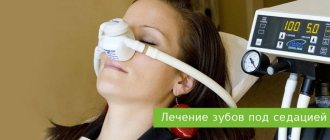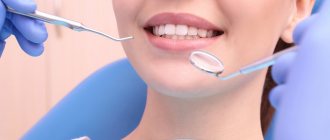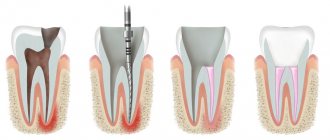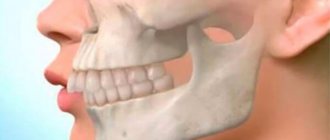There are a wide variety of dental diseases that damage the health of the teeth and oral cavity. Some pathologies - for example, primary caries - can be treated quickly and even without drilling the tooth; therapy for other diseases requires a whole course of procedures. For example, the treatment of periodontitis is always a complex process, since the disease affects not only the tooth itself, but also the tissues located next to it, which has a negative effect on the body as a whole.
If periodontitis develops to a certain stage, then all therapeutic measures may turn out to be useless and there will only be one way out - to remove the tooth. We will talk in detail about what periodontitis is, its forms, symptoms, and treatment methods in the following sections of the article.
Periodontitis: how does the disease appear and how does it develop?
Periodontitis is a term dentists use to refer to an inflammatory process that affects the tissues that surround the tooth and help keep it in the socket. The causes of periodontitis may vary in etiology (origin) and the disease is classified into subtypes. Correct diagnosis of the subtype of periodontitis is of fundamental importance: on its basis, the specialist will select the most effective treatment methods. Below we will get acquainted in detail with the forms of the disease, and also consider in detail their characteristic symptoms.
Infectious periodontitis
Dentists have to treat the infectious form of periodontitis in 90% of cases. The disease appears due to infection entering the root canals of the tooth and usually against the background of caries or pulpitis, the timely treatment of which was ignored. Infection in the canal cavities can also occur due to errors in endodontic treatment. The inflammatory process begins to actively develop from the moment pathogenic microflora enters the cavity of the dental canal. As inflammation spreads, not only soft but also hard tissues are destroyed; a granuloma can form, and if left untreated, a cyst.
IMPORTANT: The process of cyst formation can be asymptomatic, but the formation can grow to significant and dangerous sizes and lead to various types of pathologies, including deformation of the jaw joint.
What is periodontitis - about the disease
We are talking about a pathology that is accompanied by the development of inflammation in the space surrounding the root. The connective tissues responsible for holding the tooth in the socket, protecting the root from external mechanical influences and distributing the chewing load suffer. Inflammation can begin due to injury, advanced caries, pulpitis, damage to the nerves of the tooth, or after incorrect dental treatment. The infection penetrates the root canal, from where it seeps into the surrounding tissue. If the problem is not detected in time, inflammation will lead to purulent processes, and then there will be a risk of intoxication of the entire body.
Inflammatory processes are provoked by streptococcus and staphylococcus bacteria. With the development of pathology, painful sensations arise, which are aggravated by mechanical pressure on the causative tooth while chewing food. At the same time, the soft tissues begin to swell, and a pronounced painful lump may appear on the gum. Often the patient has a fever and general malaise.
“Periodontitis is not something to joke about – I know it from my own experience. I felt discomfort in one tooth for several days, but I kept putting off going to the dentist, I didn’t have time. And then in the middle of the night I woke up from terrible pain and ran to the emergency dentistry. It turned out to be acute periodontitis. I had to open it up, clean the canals, remove pus, and all this with a fever. It’s good that we managed to save the tooth! Then two weeks on antibiotics. In general, don’t delay!”
Nikita78, Moscow, from correspondence on the forum www.32top.ru
If the disease occurs in a chronic stage, there may be no acute symptoms at all or they may become paroxysmal. However, over time, the patient may notice mobility of the causative tooth and an increase in interdental spaces. In this case, the surrounding gums become red, swollen, and may bleed.
Retrograde periodontitis
This form of the disease is quite rare. Periodontitis of this form begins to develop against the background of infection penetration into the periodontium through the blood flow or lymph flow.
Traumatic periodontitis
Periodontitis of traumatic origin appears against the background of trauma, when a person receives a sufficiently severe bruise. Some medical errors made during dental treatment can lead to traumatic periodontitis:
- A small piece of an instrument that was “forgotten” after treatment in the cavity of the dental canals;
- Re-filling of the dental canal, which consists of excessive filling of filling material, which ultimately protrudes beyond the apical part of the tooth root;
- Incorrectly restored natural tooth crown, prosthesis, which constantly injure the tissues of the oral cavity.
Toxic periodontitis
This form of periodontitis usually occurs after poorly treated caries, and can occur due to tissue irritation caused by certain medications.
Each form of periodontitis has its own symptoms, but inflammation in the periodontium can also be determined by some general signs:
- Pulsating and clearly localized pain, the intensity of which gradually increases. The pain impulse intensifies at the slightest attempt to touch the teeth, during the period of their closure, while eating;
- The appearance of elevated body temperature due to toothache;
- Feeling of fullness in the area of the inflammatory process;
- Swelling of soft tissues.
IMPORTANT: Severe symptoms during the development of periodontitis are not present in all cases. Some phases of the disease can occur without the slightest external signs at all, or the person feels slight discomfort, which he mistakes for ordinary caries. Professional dental examinations, which are recommended to be carried out at least once every six months, will help to identify periodontitis in a timely manner for treatment.
Causes of periodontitis in children
Dental periodontitis in children can occur due to a number of reasons:
- as a complication of caries that was not treated;
- as a consequence of improper treatment of caries complicated by pulpitis;
- due to chemical damage to the periodontium using canal sterilization agents;
- due to injuries to soft tissues and teeth during falls or accidents.
Treatment methods for periodontitis
The treatment method for periodontitis will be selected based on the characteristics of the clinical case. Methods that are used to treat inflammation in the periodontium can be divided into two groups - conservative and surgical. However, the goal of any treatment method for periodontitis will be to obtain the following results: elimination of all tissues that are affected by the infectious process, elimination of inflammation, restoration of healthy tissue, as well as restoration of the aesthetics and functional qualities of the dental unit.
To accurately diagnose, determine the form of periodontitis and select the optimal treatment method, a number of measures are carried out: a thorough examination of the patient’s oral cavity, radiography, CT, OPTG.
Rehabilitation period and prevention
With timely dental intervention, the patient has a great chance of fully maintaining the functionality of the tooth. In advanced cases, the patient will be asked to remove the damaged tooth in order to replace it with a prosthesis, since such teeth can no longer be treated.
After the operation, the doctor may prescribe antibiotics and medicinal rinses - this helps to heal damaged and infected tissues faster. In the postoperative period, you must strictly adhere to the diet and avoid eating hard, spicy, salty and sweet foods.
Prevention of the disease, as with any other dental problems, involves mandatory oral hygiene. It is also important to carry out timely treatment of teeth and gums, and undergo regular examinations with a dentist every six months.
Therapeutic treatment of periodontitis: features and key stages
Therapeutic treatment of periodontitis is a complex, lengthy process and associated with certain difficulties. In particular, a fairly large amount of time is required to restore periodontal tissues damaged by inflammation; competent and high-quality treatment of dental canals will not be easy.
The complex of therapeutic measures for the treatment of periodontitis includes the following procedures:
- Drilling the diseased tooth to gain access to the canals;
- Work on expanding channels to a certain size, allowing for their high-quality processing;
- Painstaking cleaning of the canals from damaged and destroyed tissues;
- Flushing the canal cavity with antiseptic agents;
- Placement of antibiotic-impregnated linings into the tooth canals;
- Permanent canal filling;
- Restoration of the natural tooth crown.
Treatment of periodontitis may require repeated changes of medications in the canals, and therefore the patient is given a temporary filling for this period. After the inflammatory process can be completely eliminated, the tooth canals are filled with gutta-percha and a permanent photopolymer filling is placed on the tooth.
IMPORTANT: The more stages there are in the therapeutic treatment of periodontitis, the higher the price of the service as a whole will be.
When carrying out filling, it is extremely important to achieve complete sealing of the dental canals and all branches coming from them. After endodontic treatment of periodontitis, the doctor may additionally prescribe a number of medications for the patient to take that will help accelerate tissue recovery. Endodontic treatment of periodontitis can be supplemented by a number of physiotherapeutic procedures:
- UHF;
- Laser and magnetic therapy;
- Ozone therapy.
The need for additional physiotherapeutic procedures is determined by the dentist when drawing up a plan for the therapeutic treatment of periodontitis and based on the diagnostics performed and the characteristics of the clinical case.
Causes and symptoms of childhood periodontitis
When a child is diagnosed with periodontitis, we are talking about severe inflammation of the soft tissues adjacent to the root of the tooth. The cause of the “trouble” is most often an infectious lesion occurring against the background of complicated caries. Often, childhood periodontitis develops in response to trauma to the frontal tooth (the pulp dies and the disease develops into a chronic form). Among other provocateurs of pathology:
- the child taking potent medications;
- damage to the child’s body by viruses;
- previous cold;
- untreated caries;
- malocclusion.
The vivid clinical picture of the pathology is associated with classic symptoms of inflammation, which result in a deterioration in the child’s health, an increase in body temperature, the concentration of leukocytes in the blood, and erythrocyte sedimentation. The inflammation does not fit into the framework - it quickly spreads to adjacent areas of soft tissue, negatively affecting the condition of the future molar.
Operative (surgical) treatment of periodontitis
Surgical techniques for the treatment of periodontitis are used if conservative therapy turns out to be ineffective or initially inapplicable due to clinical reasons. In 90% of cases, doctors try to perform tooth-preserving operations, that is, resort to a type of intervention that will eliminate inflammation, but at the same time preserve the dental unit. These types of interventions in the treatment of periodontitis include:
- Resection of the root apex. It is indicated for use when cysts and granulomas are identified during diagnostic procedures. The essence of the operation is to remove all infected tissues along with the apical part of the tooth root;
- Cystectomy. During this type of intervention in the treatment of periodontitis, the formed cyst or granuloma is removed, and the apical part of the root is excised, in which inflammation has caused pathological tissue changes.
After the operations, treatment and hermetically sealed dental canals are also carried out.
Another surgical method for treating periodontitis is an operation to amputate the apex of the tooth root. But it is possible only on multi-rooted teeth and taking into account the healthy state of the other roots of the dental unit. During intervention for the treatment of periodontitis, the crown part of the tooth can be preserved completely or partially removed. In our dental clinic in St. Petersburg you can receive services for safe and painless treatment of periodontitis. At all stages of the treatment process, dental specialists will use ultra-modern dental techniques and instruments to ensure the effectiveness of the treatment as a whole and guarantee the absence of complications.
Chronic periodontitis: treatment
Treatment of this form of the disease usually takes a longer time, since in a chronic course the process affects larger areas of tissue, the infection takes root inside the affected tooth and adjacent gum and periosteum tissues. Chronic periodontitis can take various forms depending on the characteristics of the course and changes in the structure of tissues that the disease causes. There are fibrous, granulating and granulomatous periodontitis. Each variety has its own characteristics when it comes to treatment methods. For example, treatment of granulating periodontitis lasts at least four months; the same applies to the granulomatous form. Fibrous periodontitis, on the contrary, can often be cured in 2 visits, since in this form there are practically no inflammatory changes in the area of the apex of the tooth root.
As in the case of the acute form, sanitation is usually performed on the first visit: all infected and already dead tissues are drilled out, and the cavity is treated with strong disinfectants. Is it painful to treat periodontitis? Removal of diseased tissue and dead pulp is performed under local anesthesia, so acute pain can often be avoided. However, it is not always possible to completely get rid of discomfort.
At the stage of endodontic treatment, the length of the root canals is carefully measured, and then they are treated: softened dentin and pulp residues are removed, the canals are washed and tampons soaked in a strong antiseptic are placed in them. The doctor may also prescribe the patient to take broad-spectrum antibiotics, anti-inflammatory drugs and antihistamines.
During the second visit, the temporary filling and medication are removed, an examination is carried out and, if necessary, radiographic control. On subsequent visits, if there is no inflammation, the canals are sealed. The quality and density of canal filling is checked using a control x-ray.
Features of the treatment of periodontitis in teeth with previously treated canals
Retreatment of tooth canals with periodontitis is an extremely difficult undertaking, during which the dentist will have to thoroughly clean the cavities from filling material. Only a truly competent and experienced specialist can perform such work in the treatment of periodontitis, because in the course of it it will be necessary to use different methods of cleaning the canals (using specialized reagents and files) and act in fact “blindly”.
After the tooth canals are completely freed from gutta-percha, they need to be thoroughly sanitized. At this stage of treatment of periodontitis, the care and literacy of the dentist are also important, because sanitary treatment of the canal cavities should ensure the complete exclusion of recurrence of inflammation in the future.
Typically, the canals for periodontitis are washed with a specialized solution, after which the doctor places medicine in their cavities and closes the tooth with a temporary filling. In the treatment of periodontitis, a pause is made, which is necessary for the complete cessation of the inflammatory process and the beginning of regeneration of tooth tissue. As soon as the desired effect in the treatment of periodontitis is achieved, secondary permanent filling of the canals and restoration of the tooth crown with a photopolymer filling are performed.
Permanent canal filling
Permanent canal filling in the treatment of periodontitis is performed during the third visit to the dental office. Before proceeding with any manipulations, the specialist sends the patient for a control x-ray. The image will help determine the effectiveness of periodontitis treatment. If the percentage of bone tissue destruction has decreased significantly, permanent filling of the canals is performed.
The procedure begins with the removal of the temporary filling from the crown of the tooth, and then the canals are freed from the previously placed composite. The doctor will carry out an antiseptic rinse and then fill them to the apical part of the root with a composite. Upon completion of the work, the patient is given another x-ray to monitor the quality of the filling performed. Gutta-percha must be tightly packed into the canals to the very apex of the root, otherwise there is a high risk of relapse of periodontitis.
A couple of days later, the patient comes to the doctor for the fourth time and during this visit the crown part of the tooth is restored with a permanent filling to restore its aesthetics and functionality.
Traditional medicine: can its recipes help with periodontitis?
It is important to understand that periodontitis is a serious disease that affects the entire body as a whole and is fraught with serious complications. Its treatment cannot be carried out at home, since the infectious process occurs deep in the root canals of the tooth and it is important to thoroughly clean them of all tissues affected by inflammation. Only a doctor can do this - in a clinical setting and using a specialized instrument.
Remedies from folk recipes will be absolutely useless in the fight against periodontitis and, moreover, they can aggravate your condition. For example, hot compresses for periodontitis can provoke an acceleration in the rate of spread of inflammation.
Herbal decoctions and tinctures are powerless against periodontitis. They can only temporarily make the pain less pronounced, but in this case the inflammation will actively develop, affecting an increasingly larger area of tissue. If you are bothered by even a minor toothache, a reasonable solution would be to immediately consult a dentist. Remember that it is not always possible to save a tooth with periodontitis (especially with an advanced stage of inflammation).
Features of diagnostic procedures
Collaborating with a young patient is not always easy. Sometimes a child cannot determine which tooth hurts. Considering that periodontitis often manifests itself in a latent form, the task of a qualified dentist is to carefully differentiate the disease. In addition to a visual, instrumental (using a probe) examination, an x-ray is prescribed. The dentist focuses on diagnoses such as:
- caries. With a carious lesion, pathological changes in the root zone are not visible in the image;
- pulpitis. The radiograph shows partial changes in the root apex;
- periodontitis. On the x-ray, the doctor notes obvious pathological changes at the apex of the root.
Periodontitis treatment time
If you have been diagnosed with periodontitis, you should prepare for a lengthy treatment process. You will have to visit the dental clinic more than once, and in addition, strictly follow all the recommendations that the specialist will give you during the treatment process. Violation of medical recommendations can lead to complications that will increase the complexity and duration of periodontitis treatment. In the simplest case, when treating periodontitis, you will have to visit the dentist two or three times; treatment will be longer if it is supplemented by physical procedures and will require repeated placement of antibiotics into the tooth canals and consultation with highly specialized specialists. Remember that high-quality treatment of periodontitis will imply mandatory control photographs after each stage.
Radiography will allow you to track the positive changes achieved after certain procedures for the treatment of periodontitis, and evaluate the quality of canal filling. Only this approach guarantees a stable and positive result in the treatment of periodontitis and eliminates relapses of inflammation and complications.
Urgent medical care for the treatment of periodontitis
When providing emergency care to a patient during the treatment of periodontitis, the first step is to open the diseased dental unit to create an outflow of purulent contents that have accumulated in the apical zone of the root. If swelling of the gums is observed against the background of acute periodontitis, an incision is made.
The patient will have to walk with the exposed tooth for several days, after which he must visit the dentist again. During this entire period, when eating or drinking drinks, it is extremely important to cover the exposed dental unit with a cotton swab and remove it after the meal - this will prevent clogging of the canals with food debris and a possible relapse of the inflammatory process.
The emergency stage of treatment of acute periodontitis is a service that is affordable in terms of price. Its average cost ranges from 2000 to 2500 rubles. However, it is important to understand that the treatment of periodontal inflammation does not end there and it must be continued.
After the procedure of opening a tooth in the treatment of periodontitis, the patient is prescribed a course of antibiotics, rinses with antibacterial solutions, as well as anesthetics and antihistamines.
Calculate the cost of treatment by taking a short test in 20 seconds!
Do not delay your treatment, because in this matter time plays against us.
Periodontitis treatment price
The cost of periodontitis treatment is always calculated individually, because it consists of a number of factors. The price of the service will depend on the set of diagnostic measures that are carried out not only at the beginning of treatment, but also at its intermediate stages. The price of the service will be influenced by the form of the disease, method of treatment, additional procedures, equipment and drugs that can be used during its course.
If you want to know the price of periodontitis treatment or make an appointment with Uni Dent dentists, just dial our contact phone number!
Symptoms of periodontitis
Periodontitis can occur in acute or chronic form. Acute periodontitis in children is characterized by an acute onset and severe, constant, increasing pain. The pain is especially strong when pressing on the diseased tooth and when chewing on it. Other pronounced symptoms:
- swelling of the gums around the tooth;
- fever, weakness and nausea;
- enlarged lymph nodes and their pain.
Chronic periodontitis in children during periods when there are no exacerbations is practically asymptomatic. Pain can only appear when pressure is applied to the tooth or when the tooth comes into contact with something hot or cold. But besides this, other manifestations are possible:
- exacerbations with symptoms characteristic of acute periodontitis of primary teeth in children;
- formation of fistulas on the gums in the granulating form of the disease;
- drowsiness, fatigue, general weakness.
How is acute periodontitis treated?
As was said at the beginning of the article, the acute form of periodontitis is characterized by severe pain that occurs for the first time, that is, not associated with a chronic process. In this form, the disease usually occurs due to the lack of timely treatment of pulpitis or the implementation of therapeutic measures at a low professional level.
First visit
The main task at the first visit to the dentist is to ensure the outflow of pus from the purulent sac and eliminate the phenomenon of intoxication in the patient’s body. The necessary activities are carried out in the following sequence:
- An x-ray is taken to identify an acute inflammatory process or exacerbation of a chronic disease. This is of great importance, since to treat these two forms of periodontitis, you need to use different tactics.
- Anesthesia is administered.
- Tissues affected by caries are drilled out.
- The necrotic pulp is removed. This is done if the cause of periodontitis is previously untreated tooth pulpitis. If the disease arose due to poor quality of root canal filling, then the tooth filling is drilled out and the root canals are unfilled.
- The length of the root canals is measured.
- Root canals are expanded with the help of special medical instruments so that the dentist has the opportunity to fill them efficiently. In parallel, they are treated with antiseptic solutions, for which jet washing is carried out. At the end of this stage of treatment, the apical opening of the root canal is enlarged so that the pus can freely drain from the periodontium.
- In this case, a temporary filling is not applied; the tooth remains “open” until the next visit to the dental office. However, before each meal, the patient must always cover the cavity with a carious lesion with a cotton swab to prevent clogging of the root canals with food debris and disruption of the outflow of pus. If there is flux on the gum, it may be necessary to cut the gum.
Symptoms of acute purulent periodontitis
With purulent periodontitis, the main complaint is severe pain. As it grows, it acquires a pulsating character and begins to radiate to the other jaw, nose, ear, eye. Touching a tooth causes a sharp increase in pain. Swelling of the facial tissues is possible, and the tooth itself becomes mobile and may change color. Due to the accumulation of pus, it may feel as if the diseased tooth has “grown.”
Often acute purulent periodontitis causes general malaise: a person has a fever, weakness, and a headache. Due to infectious inflammation, the submandibular lymph nodes become enlarged.
The abscess can “break through.” The best outcome is when pus exits through the root into the tooth cavity. But often it spreads under the periosteum, and then periostitis develops. There is a risk of developing other serious complications - phlegmon, osteomyelitis. Therefore, treatment of purulent periodontitis must be timely.








